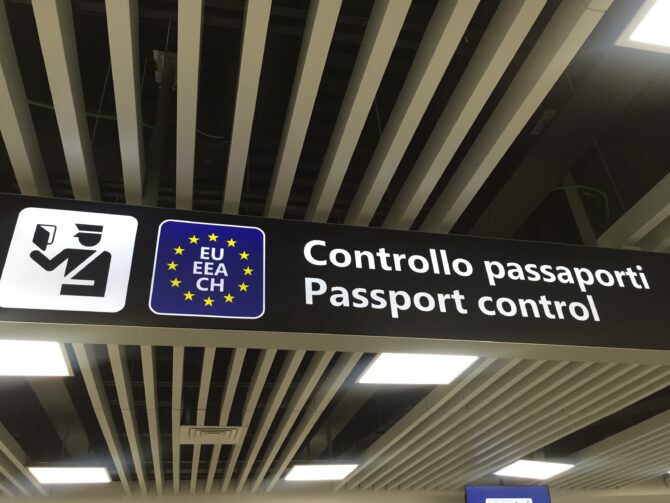Everything You Need to Know About the EU’s New Entry/Exit System (EES)
Essential Reading


The EU’s new Entry/Exit System (EES) will affect all non-EU citizens entering and leaving the Schengen Zone. Here’s everything that travellers and EU residents need to know. NOTE: The November 10th 2024 launch for the EES has now been pushed back to 2025. We’ll update this article when we know more.
What is the Entry/Exit System (EES), and why is it being implemented?
The EES, or Entry and Exit System (“Le système d’entrée-sortie” in French), is an electronic passport monitoring system designed to track visitors to the EU under the 90/180-day rule and eliminate the need for human passport checks and passport stamps.
Described as “the most advanced border management system in the world” by the European Commission, it will record information including biometric date and travel details. The main purpose of the EES is to increase security around irregular migration. Under the new digital monitoring system, everyone entering the Schengen area with a foreign passport will be tracked, and it will be easy to flag anyone who has overstayed their visa. In addition, it will make it harder for “criminals, terrorists or Russian spies to use fake passports thanks to biometric identification, photos and fingerprints.”
Which countries are affected by the EU’s Entry/Exit System (EES)?
The EES will apply to all 29 Schengen Area countries, which includes new members Romania and Bulgaria, the three EEA countries (Norway, Iceland, and Liechtenstein), and Switzerland. It will be used at all external borders of the Schengen Area, affecting all travellers entering the Schengen Zone from non-EU countries.
Do I need a visa to travel to the EU under the new EES system?
Whether you need a visa depends on your nationality and the purpose of your visit; the EES itself does not change visa requirements. Travellers from visa-exempt countries, like the US, UK, Canada, and Australia, will not need a visa for short stays (up to 90 days within a 180-day period), while travellers from non-exempt countries will continue to require a Schengen visa.
Note that a further change is set to be brought in at some point in 2025, which will require travellers from visa-exempt countries to follow an online registration prior to travel. ETIAS – the EU Travel Information & Authorisation System or ‘Système européen d’autorisation et d’information concernant les voyages’ in French – will work similarly to the ESTA short-stay visa system in the United States, and you can find out more about it here. However, this will not be in effect until November 2024, when the EES system begins, and it is not expected to be introduced until at least May 2025.
How will the Entry/Exit System affect the 90/180-day rule?
The EES won’t change anything in terms of the 90/180-day rule itself, but it aims to make the whole process easier, more secure, and less vulnerable to mistakes. Currently, while electronic records are kept of passport movements, the 90/180-day rule is primarily policed using physical stamps in your passport – your passport should be stamped on entry into the Schengen area and on departure. However, with reports of some passports not being stamped or even stamped incorrectly (especially for EU residents who shouldn’t have their passports stamped), this system has inevitably led to difficulties for certain travellers.
For most travellers, this should be a welcome change, as many (especially UK travellers since Brexit) have reported issues with the stamp system over the past year. However, for anyone hoping to flout the rules or ‘get away’ with overstaying their 90-day allowance, this system will make it much harder (if not impossible) to do so.
What happens if I overstay my visa under the EES system?
The EES will automatically flag travellers who overstay their visas or 90/180-day allowance in the Schengen Area, which will likely result in a fine and a formal request to leave the zone as soon as possible. Frequent overstayers could also find themselves with a temporary ban on entering the Schengen Zone or difficulties when applying for future visas. At FrenchEntrée, we’ve always encouraged travellers not to overstay the 90/180 days, and this system will make that advice even more crucial.
How will the EES work in practice?
The EES will replace the current system of physical passport checks and stamping by border guards with an electronic swipe-in/swipe-out system. These will be similar to the biometric passport scanners already in use at many airports, but they will register extra details such as your immigration status (for those resident in the EU or travelling with a long-stay visa) and how many days you have left of your 90/180-day allowance, as well as flagging any overstayed visas or other border/immigration offences.
These checks would only be in place at the external borders of the EU, so you wouldn’t need to swipe your passport when travelling between countries within the Schengen zone.
These electronic gates should make entering and exiting the Schengen Area quicker and easier in the long run. However, the first time that you visit after the new system comes into action, you will need to present yourself to a border guard so that your biometric data (fingerprints and facial images) can be captured. You will also need to fill in a pre-registration form with personal details such as your name, address, and date of birth. This only needs to be done one time – on subsequent visits, you can pass straight through the automatic gates.
Will there be delays for travelers to France and the EU from November?
As border controls and travel operators prepare for the introduction of the EES, there’s been a lot of discussion over the probable delays that this will cause as EU border guards will initially need to process each individual on arrival. Filling in the pre-registration forms and capturing biometric data will likely mean additional wait times and longer-than-usual queues at airports, ferry ports, and Eurostar stations.
This is part of the reason that the EES is being introduced in November rather than during peak summer season, but the reality is that there may still be substantial delays when entering the Schengen Zone.
Airlines and transport providers may ask for more information from passengers upfront in order to avoid any difficulties upon arrival, and it’s likely that you’ll be advised to arrive early and allow extra time for delays. If you are travelling to France on or after November 10th, make sure that you read any correspondence sent from your travel provider carefully and follow their recommendations to prevent adding to the delays.
Who is exempt from the EES?
Citizens of EU/EEA countries or dual nationals travelling with their EU/EEA passport are exempt from the EES rules and will not need to provide any additional details or supply biometric data. This also applies to non-EU citizens who hold a residency permit or long-stay visa for any EU country.
How will the Entry/Exit System affect non-EU citizens resident in France?
If you’re a Brit, American, or other non-EU citizen who has a French residency permit or carte de séjour then you will be exempt from the EES system. This applies when you enter or exit the Schengen Area via France or any other Schengen Area country. It’s not quite clear yet how this will work in practice, but it is likely that you will be able to use the in-person passport control desks and simply present your residency card as is already the procedure. More details on this will likely be released closer to the time.
Stay Up to Date With the Latest France Travel News
Whether you are a regular traveller to France, planning a property hunting visit, or simply visiting on vacation, our new Travel to France zone has the latest travel news, updates, and advice on everything related to travelling to France.
Share to: Facebook Twitter LinkedIn Email
By Zoë Smith
Leave a reply
Your email address will not be published. Required fields are marked *




REPLY